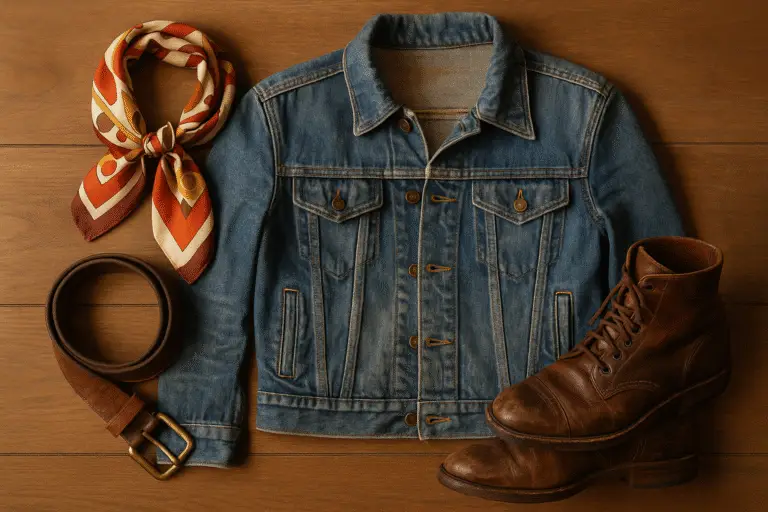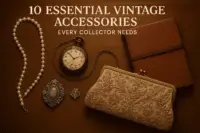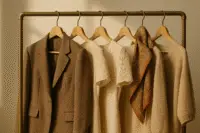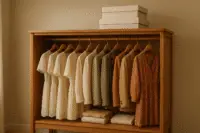Vintage clothing tells a story, but spotting the real deal takes a keen eye. Here are five clear signs to identify genuine vintage wear:
- Fabric Thinning: Over time, natural wear causes uneven thinning in high-friction areas like underarms and hems. Hold the fabric to light for subtle variations.
- Seam Stress: Look for puckering, wider seam allowances, and fading cotton or silk threads – details common in older, hand-finished garments.
- Color Fading: Natural dyes fade unevenly over decades, creating irregular patterns, especially on exposed areas like shoulders and collars.
- Hardware Aging: Metal zippers, brass buttons, and bakelite show patina, discoloration, or cracks that modern replicas can’t mimic.
- Labels and Tags: Pre-1972 pieces often lack care labels. Faded or frayed tags match the garment’s age, while pristine ones may indicate a reproduction.
These markers work together to reveal a garment’s history. For more tips, tools like the Vintage Fashion Guild’s label database can help refine your skills in identifying real vintage pieces.
How To Date Vintage Clothing – Detailed With Examples & 1920s Dress
1. Fabric Thinning and Texture Changes
One of the telltale signs of authentic vintage clothing is the natural thinning of fabric over time. Even though these garments were often made with better-quality materials and sturdy craftsmanship, decades of wear inevitably lead to subtle fabric thinning. This is especially noticeable in areas that experience frequent friction.
Key spots to check include high-friction areas like under the arms, where constant movement and perspiration take their toll over the years.
Other stress points, such as buttonholes, hems, and sleeves, can also display signs of long-term use, like fraying or slight stretching.
For a closer look, hold the fabric up to the light. Genuine wear patterns will show uneven thinning, reflecting the garment’s unique history and usage.
2. Seam Stress and Construction Details
The seams of vintage garments often reveal unique stress patterns that come from years, sometimes decades, of wear and washing.
When evaluating a garment’s authenticity, pay close attention to areas where the fabric naturally endures the most tension. These include armpit seams, side seams, and crotch areas. In genuine vintage pieces, you’ll often notice slight pulling or puckering at these points, forming small wrinkles that radiate outward from the seam line. These stress marks, which develop over time through regular use, are incredibly hard to replicate artificially.
Garments made before the 1960s often showcase hand-finished seams. These seams tend to have irregular stitch lengths and uneven tension, a stark contrast to the uniformity of modern machine stitching. Additionally, before the 1970s, you’re more likely to find pinked edges or French seams instead of the serged or overlock edges common in today’s clothing.
The thread quality and color can also offer valuable clues. Older garments often used cotton or silk thread, which tends to fade differently than the surrounding fabric. This results in subtle color variations along the seams. On the other hand, modern polyester threads retain their color much better, so perfectly matched seams might raise questions about a garment’s age.
Another hallmark of vintage construction is the seam allowance. Older pieces typically have wider seam allowances – around 5/8 inch or more – while modern garments often use narrower margins, about 1/4 inch.
These seam characteristics, combined with other wear indicators, help paint a clearer picture of a garment’s vintage authenticity.
3. Natural Fading and Color Changes
Natural fading is like a time capsule, showcasing the decades of life a garment has seen.
This fading happens as fabrics are exposed to light and air over the years, gradually breaking down the natural dyes used in older garments. Unlike today’s synthetic dyes, which are more stable, these older dyes tend to fade and change color over time, a telltale sign of true vintage. For example, a 1930s silk chiffon outfit might show dramatic color shifts from years of sunlight, while blue 1940s crepe dresses can develop purple patches, and gray fabrics may take on brownish tones.
What makes this fading even more fascinating is how uneven it often is. Different parts of a garment are exposed to varying levels of light, so areas like shoulders and collars, where sunlight hits directly, tend to fade more noticeably than parts that stay hidden. This natural, irregular fading is a hallmark of authentic vintage clothing.
On the other hand, modern reproductions often rely on artificial techniques to mimic fading, but the results are usually too uniform to pass as genuine. When inspecting a vintage piece, look for those subtle, unexpected shifts in color and uneven fading patterns. These details tell a story of real wear over time, creating a character and history that no factory process can replicate.
4. Patina and Hardware Aging
The hardware on vintage clothing, like zippers, buttons, and buckles, tells its own story through the patina it develops over time. This natural aging process, caused by years of use, oxidation, and exposure to the elements, adds character and reveals the garment’s journey. Just like worn fabric or stressed seams, aged hardware is a hallmark of authenticity.
Durable metals from earlier eras, such as brass, copper, iron, or steel, were designed to stand the test of time. These metals age in unique ways, developing rich, irregular patinas depending on the alloy and conditions they’ve endured. For instance, brass buttons from the 1940s might show a deep green patina, while steel buckles often feature a mix of surface rust and smooth, polished areas where they were frequently touched.
Metal zippers are another key feature of vintage clothing, especially in pieces made before the 1970s. Brands like Scoville, Universal, Talon, and Crown produced sturdy metal zippers that are a telltale sign of mid-20th-century or earlier garments. Over time, these zippers show their age through subtle discoloration of the metal teeth or a pull tab that’s been smoothed by years of use.
Buttons also provide clues about a garment’s age and authenticity. Before plastic became widespread, buttons were crafted from materials like bakelite, glass, horn, wood, mother of pearl, or metal. Each of these materials ages in ways that modern plastic cannot replicate. A bakelite button from the 1930s, for example, might display tiny cracks or a yellowed hue, while mother of pearl buttons develop a soft, evolving luster over time.
In contrast, modern reproductions often rely on cheaper materials like aluminum or pot metal, which either don’t age at all or exhibit artificial aging that looks overly uniform and lacks the organic randomness of genuine wear. This is a dead giveaway when comparing authentic vintage hardware to modern replicas.
When inspecting vintage pieces, take note of how the hardware has aged. Authentic wear creates uneven patterns, areas that were frequently handled will show more wear, while spots that were less exposed retain their original finish. This natural variation is nearly impossible to fake convincingly, making it one of the most reliable signs of true vintage craftsmanship.
5. Label, Tag, and Documentation Markers
Labels and tags on vintage clothing are like a garment’s birth certificate, offering key details about its age and authenticity. These small but crucial elements help collectors figure out whether a piece is genuinely vintage or just a modern reproduction. After physical wear and tear, documentation details provide another layer of insight into a garment’s origins.
One of the most reliable ways to date vintage clothing is by looking at care instruction labels. For example, garments made before 1972 often lack care labels entirely. This is because the Federal Trade Commission’s “Care Labeling Rule” didn’t come into effect until that year. On the flip side, if you find detailed washing or drying instructions, the piece is likely from 1972 or later.
Pay attention to the condition of the labels. Signs of age, like fading or fraying, should match the overall wear of the garment. If the labels look too new or pristine on an otherwise aged piece, it could be a red flag for a modern reproduction.
Just like wear patterns and hardware, original labels are a key part of a garment’s story. For those eager to dive deeper into vintage fashion authentication, resources like AllVintageStyles provide detailed guides and tips to help you spot authentic vintage pieces with confidence.
Conclusion
Recognizing authentic vintage clothing comes down to understanding the telltale signs of natural aging. Look for fabric thinning, stressed seams that reflect years of wear, unique fading patterns, and patina from oxidation. Even the labels act as historical markers, offering clues about the item’s origin and era.
These indicators often work in harmony. Genuine vintage pieces typically exhibit several of these aging traits together. Today, traditional methods are bolstered by modern tools. Technologies like AI, such as Entrupy’s system with a 99.1% accuracy rate, and resources like the Vintage Fashion Guild’s label database make authentication even more precise.
FAQs
How can I tell if a piece of clothing is genuine vintage or a modern reproduction based on fabric and seams?
When spotting genuine vintage clothing, take a close look at the fabric and seams. True vintage pieces often showcase fine craftsmanship with details like hand-stitched hems, French seams, or other handmade touches that are rare in modern reproductions. The fabrics might reveal natural signs of aging, such as uneven fading, soft textures, or slight discoloration – qualities that develop over decades and are hard to replicate artificially.
You’ll also notice that the seams in authentic vintage garments may show some wear, like minor loosening, but they still reflect the careful skill with which they were originally made. In contrast, modern reproductions often rely on machine stitching and synthetic materials, which can appear too perfect or lack the unique charm of truly vintage clothing.
How can I verify if a vintage clothing label or tag is authentic?
When checking vintage clothing labels and tags, focus on key details like copyright years, union labels, and RN numbers. These can often reveal the garment’s age and where it was made. For high-value pieces, using label databases or seeking help from professional authentication services can be a smart move.
Look closely at wear patterns and printing methods. Authentic vintage tags usually display signs of natural aging or design features typical of their time. If you’re uncertain, turn to trusted vintage fashion guides or connect with experts to confirm authenticity.
Why is aging on hardware important for identifying authentic vintage clothing, and what signs should I check for?
When it comes to spotting authentic vintage clothing, the condition of the hardware can be a dead giveaway. Natural wear and tear that develops over time is tough to replicate, making it one of the best clues to an item’s age and originality.
Pay close attention to slight discoloration, surface scratches, rust, or a patina on metal elements like zippers, buttons, and clasps. You might also spot small cracks or loose fittings in these parts. These imperfections are proof of real use over the years, offering insight into the garment’s history and helping you separate genuine vintage pieces from modern reproductions.



